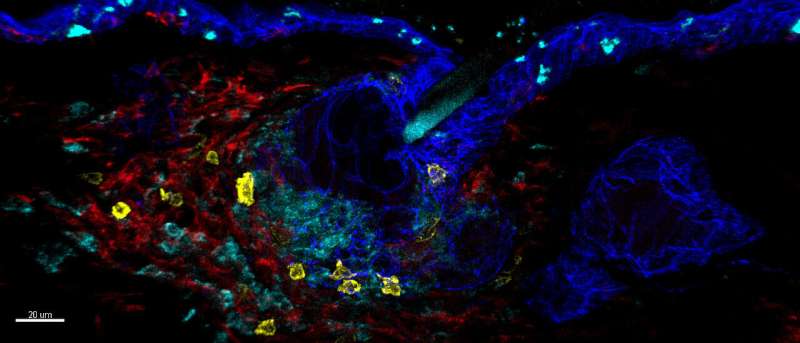This article has been reviewed according to Science X's editorial process and policies. Editors have highlighted the following attributes while ensuring the content's credibility:
fact-checked
peer-reviewed publication
trusted source
proofread
Research discovers innate immune cells are more adaptable than previously thought

Natural killer (NK) cells, part of the innate immune system, can permanently remain in infected tissue and thus contribute to immunological memory, researchers at the University of Würzburg have discovered.
A team of the Max Planck Research Group for Systems Immunology led by Würzburg immunologist Georg Gasteiger has published these surprising findings in the journal Immunity. During local infections in the skin, these cells can migrate into the tissue and remain there long-term. In doing so, they contribute to the immunological memory. The fact that lymphocytes of the innate immune system possess these abilities was not known until now.
The immune system consists of an innate part and an acquired part. The innate immune system protects us from germs from birth, while the adaptive immune defense is learned over the course of life: It demonstrates significant adaptability to new or altered pathogens and forms the so-called immunological memory. This allows our body to react more quickly to repeated contact with pathogens, as is exploited in vaccinations, for example.
NK cells are lymphocytes of the innate immune system. Their name says it all—they eliminate virus-infected cells or tumors. Therefore, they have been extensively studied in the field of tumor therapy. A less-known area until now has been their role in tissues.
Surprising adaptability in skin immune defense
The skin is not initially populated with these specialized immune cells at birth. The Würzburg Max Planck Research Group's team demonstrated that NK cells only settle there after an infection. "We were surprised that a specialized subset of NK cells that migrate to the skin during an infection also remain there long-term," says Christin Friedrich, first author of the study and postdoctoral researcher in the research group. "We previously primarily knew about immune cells settling in tissues long-term after infections from cells of the adaptive immune system, such as T cells."
Previously, it was believed that natural killer cells, belonging to the innate immune system, were rather short-lived cells that mainly circulate in the blood and only temporarily move into inflamed tissues during an infection.
"We were able to show that these cells can react much faster during a second infection because they are already present at the site," explains Gasteiger, head of the research group. So, the innate system seems to learn more than previously thought and can adapt in tissues to recurring threats from pathogens. "Perhaps these mechanisms were established early in evolution, even before the adaptive system developed," says the immunologist.
Immune cells in shingles and erysipelas patients
In the next step, the scientists aim to verify their approach in human tissues and learn more about the underlying mechanisms. In collaboration with the University Hospital of Würzburg, they will examine natural killer cells in patients who have had shingles and erysipelas after the infection has been overcome.
"We want to understand why these cells can only colonize specific tissue niches and what they need for it," says Gasteiger. Understanding how NK cells function in different tissues could help target improvements in vaccinations and immunotherapies.
More information: Tommaso Torcellan et al, Circulating NK cells establish tissue residency upon acute infection of skin and mediate accelerated effector responses to secondary infection, Immunity (2023). DOI: 10.1016/j.immuni.2023.11.018



















